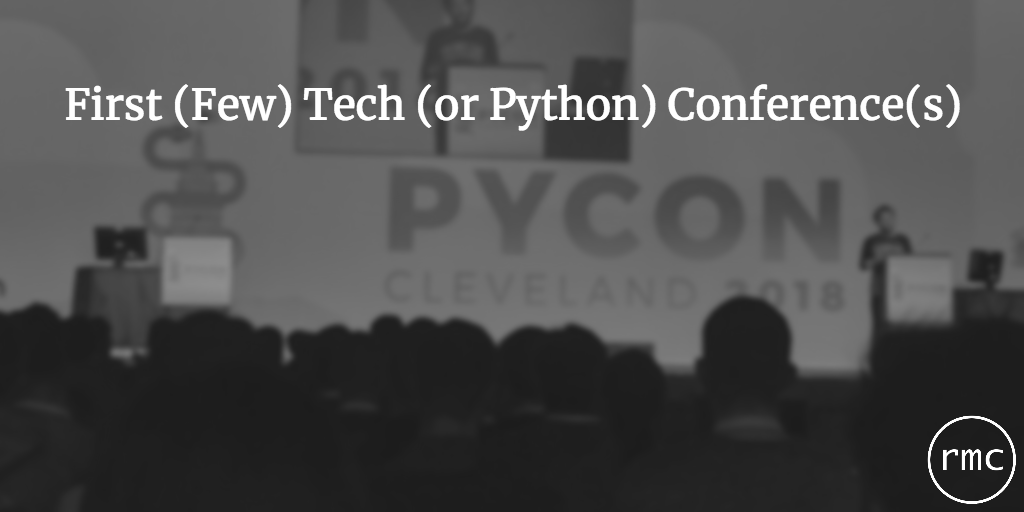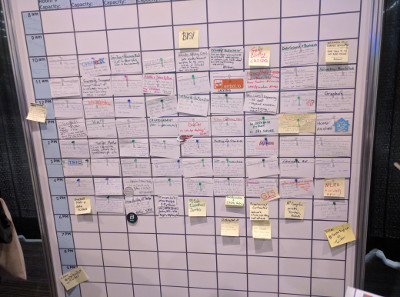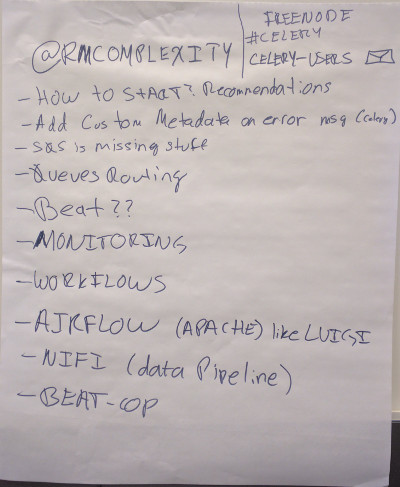
First (Few) Tech (or Python) Conference(s)
Although this article comes quite late since PyCon 2018 ended back in May and this post was originally written to describe my first PyCon. I was hesitant to publish this article since I never got around to edit it. I decided to publish it but focusing more on the things I think every newcomer should try at PyCon or any other tech (or python related) conference.
PyCon 2018 has come to an end. A bittersweet feeling still lingers with me after a few days of returning to my usual routine. Thankfully, I was able to interact with a lot of interesting people. The venue’s air was always filled with ideas. Navigating from conversation to conversation, planting curious seeds in any attentive mind nearby. Authors of widely used libraries and frameworks were being humanized by all the interactions between said authors and the rest of the community. Little by little GitHub handles transformed into approachable peers. A welcoming sense of belonging filled the halls. One can truly appreciate the great effort from the organizers which is poured into this conference. An event made by the python community for the python community.
This feeling of community is not unique to PyCon, it is a constant in every python related conference I’ve been to. In reality, it has much less to do with the people organizing the conference and more with who and how you approach your peers.
Key Notes
To this day I am not sure how any conference select their keynotes. I assume the conference chairs get together and take into consideration anyone who, in the past year, has done anything noticeable enough. Noticeable enough is probably measured by the impact in the community as a whole. This is only an assumption, which is as good as any assumption from any other carbon based person. I can only imagine how hard this exercise might be.
The first PyCon 2018 keynote by Dan Callahan (@callahad) was particularly interesting to me since Dan works for Mozilla, and he was talking about how the web is a platform and is the most popular platform. Javascript (JS) is native to the web and JS is a very popular language. Dan was presenting WebAssembly as an alternative to use JS on the web. WebAssembly allows for development of web applications in other languages. The idea is that we can bring python into the web.
Why are we programming if not to serve people and solve human problems?
-- Dan Callahan, PyCon 2018 Keynote
Not every keynote is about introducing new technologies. Ying Li’s @cyli) keynote was very interesting with a very different format than Dan Callahan’s. Ying Li talked about security and how to make sure our applications are secure. I highly recommend watching Ying Li’s keynote video. I remember one of the first keynotes I saw live was Andrew Godwin’s keynote at DjangoCon US 2016. He was presenting some advanced techniques with Django Channels, which back then was on the 1st version. Andrew’s keynote wasn’t the first keynote I saw, but I didn’t really pay that much attention to the keynotes at the other two tech conferences I went before DjangoCon US 2016. I wasn’t really sure what keynotes were about. The good thing is that now we can re-watch a lot of keynotes in Youtube. I’m catching up.
If the conference you attend posts the keynotes on Youtube you should try to attend to the keynotes live. It’s always interesting to see things happen live, you can pick up some pointers for future talks. Another thing I like about attending keynotes is that most of the conference will surely attend, one can meet a lot of interesting people before, after or even while the keynote is happening.
Talks
A great reason to attend a conference is its lineup. A lot of conferences are able to invest in a good audio-visual package, and they are able to record every presentation at the conference. This is great since one can go back and re-watch interesting talks. Sometimes this is taken as if it is not that good of an idea to actually attend the presentation. Let me tell you that is not so black and white. The fact that talks are recorded give the attendees some freedom to do more things at a conference, which we’ll talk about later. Watching a talk live has its own rewards. The main upside I see about attending talks is that, most of the time, you get to ask questions to the speaker. Some speakers prefer to not use time from their talk on questions from the public, instead you can probably approach the speaker afterwards.
Attending conferences can feel overwhelming. It's OK if you feel overwhelmed,
-- Josue B. Coronel
try to look for someone who can help you.
Experiencing a conference in person has great advantages it can also get overwhelming. Remember that it is OK to feel overwhelmed while at a conference. I tend to feel pressured to attend every talk mainly because I’ve been able to get my employer to pay for the conferences I’ve attended. The fact that somebody else is paying for my ticket makes me feel it’s part of my job to participate in as many things as possible in a conference. While this might be partially true, we also have to remember to take care of ourselves. It’s OK to go to the hotel room or Airbnb, or go to a silent room (if you have access to one), or maybe just go and grab some lunch outside of the conference to avoid feeling too overwhelmed. Believe me, you will feel better and you will even retain more information. There is a great article by zapier about attending a conference as an introvert.
Open Spaces
This year’s PyCon was the first time I attend PyCon and was the first time I experienced, firsthand, what Open Spaces are. I’ve been to different conferences with an Open Space track, but for some reason in this year’s PyCon people were talking more about going to open spaces. I was not sure what to expect of an open space and it seemed everyone was already acquainted with how the whole thing worked. Let me summarize what open spaces are, at least to me: Open Spaces are a particular gathering format where the content is created by whomever attends. I know DjangoCon US has open spaces some years, which is awesome. I found this year’s PyCon used a couple big grid boards where you could place a post-it (or card) with the topic of an open space. These grid boards where right in the middle of the hallway so everyone noticed them. I am hoping to participate in this year’s DjangoCon US’s open space track. Below is a picture of the grid boards used by this year’s PyCon.

I soon realized that it’s a great way to have more personal conversations about a specific topic
with other conference attendees. The idea is to place a post it on the schedule, which anybody can do,
and propose a topic. I saw topics ranging from pipenv to chocolate. Any topic is OK.
After you’ve chosen a slot and a topic you show up at the reserved room and wait for people to come.
Then the open space starts. In the Open Space’s User Guide mentions that an open space
starts when it has to start. This is a more informal way of gathering people and talk about stuff.
I went to a very interesting open space about Geographic Information Systems (GIS) and then to a
writing open space lead by the one and only Bruce Eckel.
Attending to a few open spaces made me realize I wanted to participate more. I went on and looked for a spot on one of those big grid boards. The slot was on the last day of the conference and I thought this was better, that way I wouldn’t feel bad if people didn’t come. I wrote on a piece of paper “Task Queues (Celery and such)”. I started telling some new people I met at the conference about the Open Space I was organizing, and they all responded with supporting words. The time had come and there were a good 15 or 20 people waiting in the room. It was great!. I gave a small introduction about what the topic meant and about me. After my introduction I invited everyone in the room to say their name and mention any topic about Task Queues they needed help with or wanted to know more about. With this exercise the conversation started flowing. I was able to take notes on the main topics we talked about, below you can see an image of these notes.

If you are thinking about organizing an open space in your next conference I have three things to say that helped me on my very first open space:
- Let the conversation flow but beware some people won’t know what specific acronyms or “lingo” means. It’s ok to ask whomever is talking to explain what they mean for the rest of the group.
- Try to take notes, either on a white board or a big piece of paper. Leave your details on top of wherever you’re taking notes and make yourself available afterwards.
- It’s OK to interrupt someone if you think the conversation is being monopolized into one topic. There are more people and an open space is made by everyone.
The Hallway Track
Finally, do not miss on the hallway track. The hallway track is everything that’s happening on the hallways. There’s usually people meeting other people or great conversations starting on the hallways. Remember to always approach people respectfully and your doors will open to stimulating conversations. Approaching somebody could be as simple as asking them what event are they going to attend next, or where are they from. Don’t feel bad if they don’t want to talk at that specific moment, maybe they’re feeling overwhelmed. Remember to always: have fun, learn stuff, meet people, and let yourself be inspired. Everything except for having fun is optional.